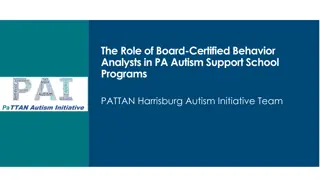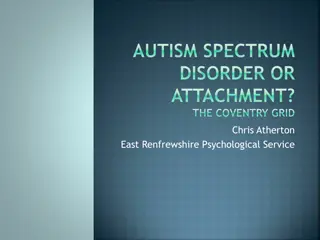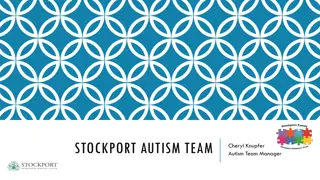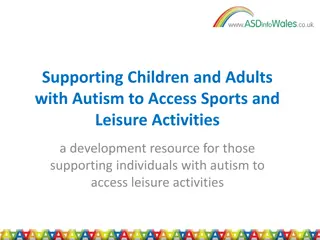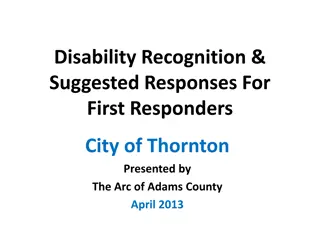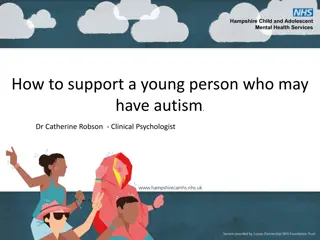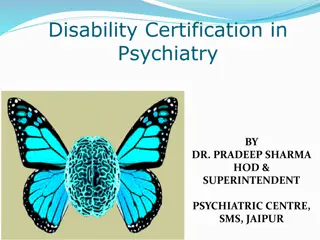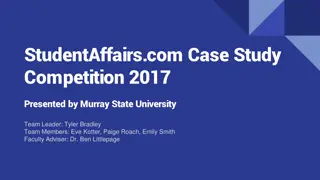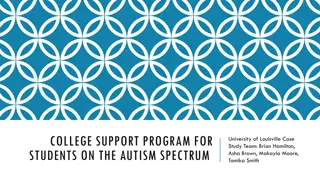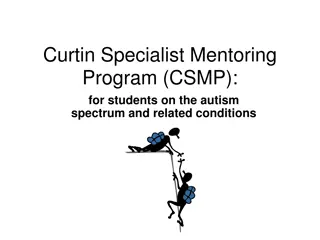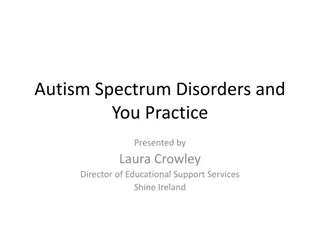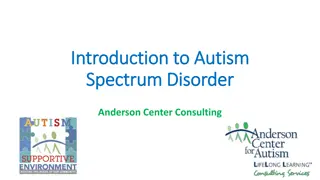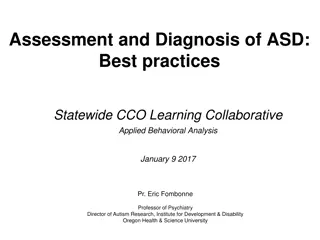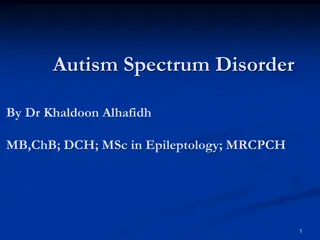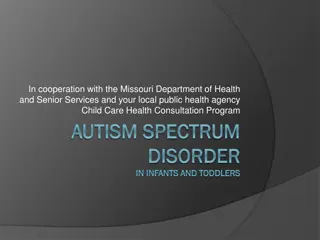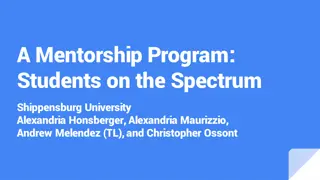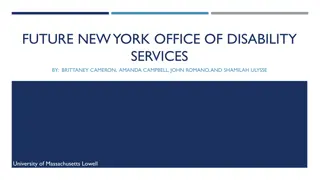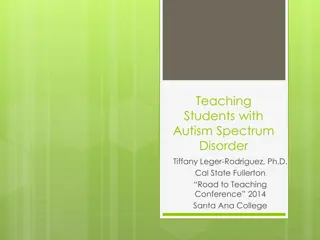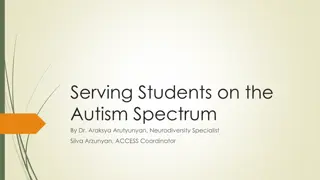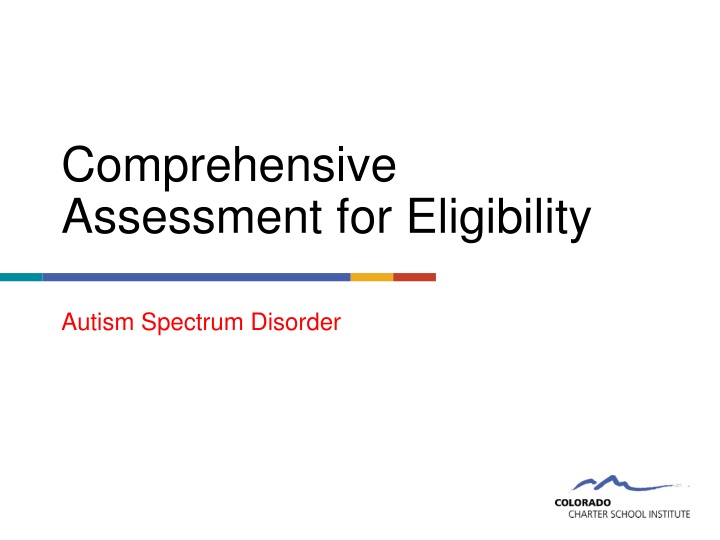
Comprehensive Assessment for Autism Spectrum Disorder Eligibility
Explore the comprehensive assessment process for determining eligibility for Autism Spectrum Disorder. Learn about evaluation rules, procedures, and criteria for assessing children's educational needs to provide appropriate special education and related services. Assessments are designed to be culturally sensitive, administered in the child's preferred language, and cover a wide range of areas including health, vision, hearing, social and emotional status, academic performance, and motor abilities.
Download Presentation

Please find below an Image/Link to download the presentation.
The content on the website is provided AS IS for your information and personal use only. It may not be sold, licensed, or shared on other websites without obtaining consent from the author. If you encounter any issues during the download, it is possible that the publisher has removed the file from their server.
You are allowed to download the files provided on this website for personal or commercial use, subject to the condition that they are used lawfully. All files are the property of their respective owners.
The content on the website is provided AS IS for your information and personal use only. It may not be sold, licensed, or shared on other websites without obtaining consent from the author.
E N D
Presentation Transcript
Comprehensive Assessment for Eligibility Autism Spectrum Disorder
Comprehensive Evaluation ECEA Rules: 1CCR 301-8 4.02(4) Initial Evaluation Process An initial evaluation process for children ages 3-21 shall be provided for the purposes of determining whether the child is a child with a disability under Section 2.08 of these Rules and what the educational needs of the child are. The requirements and procedures for initial evaluations shall be in accordance with 34 CFR 300.301, 300.304 and 300.305 and shall ensure that the initial evaluation is sufficiently comprehensive to appropriately identify all of the child s special education and related services needs, whether or not commonly linked to the disability category in which the child has been classified.
Sec. 300.304 Evaluation Procedures Assessments and other evaluation materials used to assess a child under this part Are selected and administered so as not to be discriminatory on a racial or cultural basis; Are provided and administered in the child s native language or other mode of communication and in the form most likely to yield accurate information on what the child knows and can do academically, developmentally, and functionally, unless it is clearly not feasible to provide or administer; Are used for the purposes for which the assessments or measures are valid and reliable; Are administered by trained and knowledgeable personnel; and Are administered in accordance with any instructions provided by the producer of the assessments. Assessments and other evaluation materials include those tailored to assess specific areas of educational need and not merely those that are designed to provide a single general intelligence quotient.
Sec. 300.304 Evaluation Procedures continued: Assessments are selected and administered so as best to ensure that if an assessment is administered to a child with impaired sensory, manual or speaking skills, the assessment results accurately reflect the child s aptitude or achievement level or whatever other factors the test purports to measure, rather than reflecting the child s impaired sensory, manual, or speaking skills (unless those skills are the factors that the test purports to measure). The child is assessed in all areas related to the suspected disability, including, if appropriate health, vision, hearing, social and emotional status, general intelligence, academic performance, communicative status, and motor abilities. Assessments of children with disabilities who transfer from one public agency to another public agency in the same school year are coordinated with those children s prior and subsequent schools, as necessary and as expeditiously as possible, consistent with 300.301(d)(2) and (e), to ensure prompt completion of full evaluations. In evaluating each child with a disability under 300.304 through 300.305, the evaluation is sufficiently comprehensive to identify all of the child s special education and related services needs, whether or not commonly linked to the disability category in which the child has been classified. Assessment tools and strategies that provide relevant information that directly assists persons in determining the educational needs of the child are provided.
Autism Spectrum Disorder A child with Autism Spectrum Disorder (ASD) has a developmental disability significantly affecting verbal and non-verbal social communication, social interaction, engagement in repetitive activities and stereotyped movements, and resistance to environmental changes or changes in daily routines which prevents the child from receiving reasonable educational benefit from general education. ECEA 2.08(1)
Eligibility Criteria for ASD A developmental disability significantly affecting verbal and nonverbal social communication and social interaction, generally evidenced by the age of three. Other characteristics often associated with Autism Spectrum Disorder are engagement in repetitive activities and stereotyped movements, resistance to environmental changes or changes in daily routines, and unusual responses to sensory experiences.
Eligibility criteria for ASD cont. The child displays significant difficulties or differences or both in interacting with or understanding people and events. Examples of qualifying characteristics include, but are not limited to: significant difficulty establishing and maintaining social- emotional reciprocal relationships, including a lack of typical back-and-forth social conversation, And/or Significant deficits in understanding and using nonverbal communication including eye contact, facial expression, and gestures): and
Additional Criteria The child displays significant difficulties or differences that extend beyond speech and language to other aspects of social communication, both receptively and expressively. and The child seeks consistency in environmental events to the point of exhibiting significant rigidity in routines and displays marked distress over changes in the routine, and/or has a significantly persistent preoccupation with or attachment to objects or topics Examples of qualifying characteristics include, but are not limited to: an absence of verbal language or, if verbal language is present, typical integrated use of eye contact and body language is lacking, and/or significant difficulty sharing, engaging in imaginative play and developing and maintaining friendships;
Possible Characteristics of ASD Delays or regressions in motor, sensory, social, or learning skills; and/or Exhibits precocious or advanced skill development, while other skills may develop at or below typical developmental rates; and/or Exhibits atypicality in thinking processes and generalization. The child exhibits strengths in concrete thinking while difficulties are demonstrated in abstract thinking, awareness and judgment. Perseverative thinking and impaired ability to process symbolic information are present; and/or Exhibits unusual, inconsistent, repetitive, or unconventional responses to sound, sights, smells, tastes, touch, or movement, and/or Exhibits capacity to use objects in an age-appropriate or functional manner is absent or delayed. Difficulty displaying a range or interests or imaginative activities or both; and/or Exhibits stereotypical motor movements, which include repetitive use of objects and/or vocalizations, echolalia, rocking, pacing, or spinning self or objects.
Differences Educational Identification And Medical Diagnosis
Information Included in the Assessment or Evaluation Child Find or IEP Team Academic Achievement across several areas Observation of behaviors in structured and unstructured school situations Direct Observation of social and communicative behaviors Family interview for developmental and family history Assessment of ASD characteristics Teacher/Family report of problem behaviors and adaptive skills May include: Standardized assessments of intellectual functioning, language, motor skills, learning style, adaptive behaviors Existing educational records and medical clinical reports, as provided by the family Psychologist, Psychiatrist or Physician Medical, family, and developmental history Caregiver reports of current functioning across settings Direct observation of social and communicative behaviors Further investigation into attention, mood, or other aspects of mental health as needed Standardized assessments of overall intellectual functioning, speech and language, motor, and/or adaptive behaviors May include: Physical exam, genetics testing Neurological exam or other relevant medical follow-up Existing educational records and medical /clinical reports as provided by the family
Functional Impairment Educational Identification The condition must affect educational performance (such as academics, ability to communicate effectively, work in groups, and acquire the necessary social competence to be successful after high school) Clinical Diagnosis The condition must impair everyday functioning to be clinically diagnosed.
Results are intended for: Educational Identification Developing the student s IEP, (including identifying appropriate educational goals and objectives, accommodations, modifications, and determination of the least restrictive environment) to provide the student with a free and appropriate education. Medical Diagnosis Guiding the parents to appropriate next steps in intervention (both in and outside of school) to promote overall wellness and optimal outcomes for youth with ASD and their families.
Student Educational History Date of Previous schools attended with grade levels Grade level of student enrollment, grade level of enrollment History of special education/Section 504/READ Plan/ML Plan Referral Information
MTSS/RTI Interventions Diagnostic assessment results Detailed and specific information Goals Interventions Length of interventions Progress monitoring Increase of time and intensity as needed Modified interventions as needed Gap size and/or rate of improvement (CBM measures) Pre and post data
Current Educational Information Cognitive, School attendance Achievement, Behavior referrals and discipline notices Adaptive skills, Educational records review and teacher interview of: Communication skills, Objective data on classroom performance (grades on assignments, grades of tests, credits) Motor abilities, and District and State assessments Social/emotional abilities
Current Educational Information cont. Work samples/portfolios of student work In a structured environment (including the regular classroom setting Document academic performance and behavior At least two observations by special education provider(s) trained in conducting observations (date and name/title of observer) In a non-structured environment Document social interactions and pragmatic language
Teacher Input General education teacher input with a focus on the child s; Social, Communication, and/or Play activities. In natural activities and routines and the need for structure and modification to encourage the child s participation in learning.
Psychosocial/Cultural History Parent/Student Interviews to Include; Behavior/social skills development Family background Environmental background Social background Cultural background Developmental history Interviews should be conducted by trained personnel.
Health Assessment Vision and hearing screen Past and current health status reports Birth history Conducted within the year Provide data and results Outside medical/clinical reports provided by the parents. Medications
Standardized Diagnostic Assessment for Autism Include any outside medical/clinical evaluations and/or reports Formal/standardized Autism assessment
If Multilingual Home Language survey ACCESS Scores WIDA Scores Review of comparison to like peers Review of ML supports
Vocational Assessment if the student is 15 or in the 9thgrade.
Standardized Assessments In Areas of Concern Sensory Profiles Motor foundation and motor planning Speech/Language/Communication Pragmatic Language Cognitive Consider a split between verbal and nonverbal intellectual potential Adaptive Consider a discrepancy between IQ and adaptive skills Social/emotional Executive Functioning Academic Achievement
Summarizing the Information Look for consistencies: Is it pervasive across settings and people? If there is a history of trauma, abuse, or neglect, or in the case of foster care or adoption where there is no early history, consider other possibilities for the behaviors observed. Look for the impact that the features of Autism have on their educational performance. Are there academic challenges, such as reading comprehension or writing? Do the social challenges interface with working in small groups, participating in classroom activities, or making healthy relationships? Are rigid patterns of thinking and/or other behavior affecting learning or the school environment? When considering restrictive areas of interest or repetitive behavior, consider the intensity, frequency, and duration level.
Assessment Instruments for ASD These are common formal assessments that might be administered to provide the team with the scores and information needed to assist in the eligibility determination of a student with ASD. This is not meant to be an exhaustive list. Note: Standardized assessments are generally re-normed every ten years. Please be sure you are using the most recent assessments and protocols. Select at least one assessment in each area of concern.
Formal Assessments for ASD Select from the following: Autism Diagnostic Interview R (ADI-R) Autism Diagnostic Observational Schedule Revised (ADOS-2) Childhood Autism Rating Scale 2ndEdition (CARS- 2) Checklist for Autism Spectrum Disorder (CASD) Gilliam Autism Rating Scale 3rdEdition (GARS-3) Asperger Syndrome Diagnostic Scale (ASDS)
Formal Assessments for Communication Select from the following: Receptive Clinical Evaluation of Language Fundamentals 5 (CELF- 5) Preschool Language Scales 5thEdition (PLS-5) Expressive Clinical Evaluation of Language Fundamentals 5 (CELF- 5) Preschool Language Scales 5thEdition (PLS-5) Use of Symbol Systems Objects, photos, tangible symbols, picture communication symbols, sign, writing, engagement of people to gain desired objects, people actions, joint attention, initiation.
Communication Assessments for ASD cont. Use of people as means to ends Of communication exchange Use of immediate or delayed echolalia for communicative function Pragmatic functions Pragmatic Language Checklist Communication Matrix Conversational Effectiveness Profile (CEP-R) Test of Pragmatic Language (TOPL-2) Social Language Development Test Elementary and Adolescent Social Communication Questionnaire (SCQ) Social Responsiveness Scale (SRS) Double Interview from Thinking About You, Thinking About Me
Social and Emotional Development Select from the following: Assessment of Social Skills for Children with Autism Behavior Rating Inventory of Executive Functioning (BRIEF) Adaptive Behavior Assessment System 3 (ABAS-3) Behavior Assessment Scale for Children 3 (BASC-3) Functional Assessment Screening Tool (FAST) Functional Behavioral Assessment (FBA) Vineland Adaptive Behavior Scales 3rdEdition TRIAD Social Skills Assessment School Assessment Rating Scale for Asperger s Syndrome Social Responsiveness Scale (SRS)
Observations in Structured and Unstructured Settings Select from the following: Social Interaction Observation Form Structured Student Interview Asperger Syndrome Pragmatic Language Scale 5 Observation report by a person with knowledge of ASD
Sensory Needs Assessment Sensory Profile
Executive Functioning Select from the following: Wechsler Intelligence Scale for Children 5 (WISC-V) Behavior Rating Inventory of Executive Functioning (BRIEF) Test of Problem Solving 3 (TOPS-3)
Resources Guidelines for the Educational Evaluation of Autism Spectrum Disorder https://www.cde.state.co.us/cdesped/asd_guidelines Autism Program Quality Indicators https://www.cde.state.co.us/cdesped/autismqualityindicators_pdf FAQ for Educational Identification of ASD in Young Learners (3 5) www.cde.state.co.us/cdesped/faq-ed-id-early-learners ASD Office Hours https://www.cde.state.co.us/cdesped/sd-autism#Resources
CDE ASD Specialists Brook Carson, Ph.D 720-215-8647 Carson_b@cde.state.co.us Rhonda Danner, M.A. 720-460-8368 Danner_r@cde.state.co.us
CSI Resources Special Education Director Nick Stachokus nickstachokus@csi.state.co.us Assistant Director Matt Hudson matthudson@csi.state.co.us
CSI Special Education Coordinators Colorado Springs/Denver Metro Lora Bonney lorabonney@csi.state.co.us Front Range Karen Davidson karendavidson@csi.state.co.us Western Slope Donna Day donnaday@csi.state.co.us Denver Metro/Northern Front Range Cait Eggleston caiteggleston@csi.state.co.us Denver/Aurora Metro Region Lynette Steinhoff lynettesteinhoff@csi.state.co.us
Additional CSI Resources 504/School Nurse Coordinator Brian Printz brianprintz@csi.state.co.us ELD Coordinator Rachel Franks rachelfranks@csi.state.co.us Early Learning and School Support Coordinator Willynn Webb willynwebb@csi.state.co.us CSI Resource Page https://resources.csi.state.co.us/special-education

